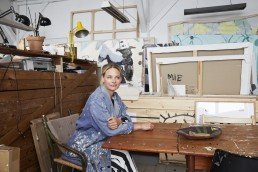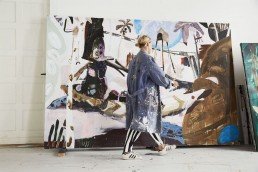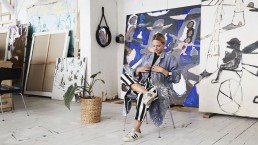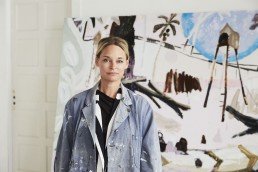Interviews
A Conversation With Artist Mie Olise Kjærgaard
In a series of interviews, we zoom in on a selection of people who literally put art first, letting their lives unfold with, in-between and through art. The Art First Series features strong voices who share their ideas about why art matters to them, having become a crucial part of their existence. By introducing a new way to think and speak about art, Art First seeks to foster a new conversation about art and its vital importance in today's society.

Why do we need art in our lives?
Art is crucial on so many levels, because it offers a completely different perspective than the rest of our capitalistic society does. Art makes you wonder, ask questions, take the long and winding road between A and B, in opposition to the direct and shortest way.
What does it mean to be an artist today? How would you like to contribute to the art world?
Art is becoming more and more important in a world, that is increasingly and exclusively focusing on efficiency, making our climate and minorities pay (think about how that will end!). Whether the artist’s focus is formalistic, political, or more poetic, the artist shows another way – that you can take the time to explore, go into another world or look at the one you know from a different angle. I believe that this way of thinking offers the way to live, when climate change and corruption has proved that the linear capitalistic model will put an end to mankind. We will have to ask completely different questions, and that is what art is already doing. I am making art because it’s the only way I can exist. I am a creator. I am a painter. I build, create sculptures, and love to work in the studio to make things emerge out of nothing. I work with dystopian man-made constructions, because I think it’s urgent to relate to which future we will be entering, and my practice lies between a very literal critique of the society we have built, as well as a more poetic fictional world.
As for contributing to the world, I would like to create work and install it, so the viewer will get some kind of experience, wonder about their own life, about our society, and maybe even change something in their life. I would like for people to feel something in their gut, when they see my work – rather than trying to understand it with their brains – my work is a visual language, that you hopefully will explore through your entire system.

Which difference does it make for you to be surrounded by art on a daily basis?
It makes me sane, it makes me connect to myself and the world and remember that I can stop and walk backwards, instead of hazing from the one to the other. I can explore what the artist did, walk the road he walked, while thinking about all sorts of things at the same time. It opens my mind.
Can you recall any particular art experience that literally changed the way you perceive the world and live your life?
I had my first big art experience when I saw a Kiefer painting, as a 15-year-old. I decided, I wanted to be a painter and started large-scale right away. Later exploring Janet Cardif’s many audio-walks around the world, as well as her other sound-installations (Tate Britain, Hamburger Bahnhof, Louisiana), Ragnar Kjartansson at the Venice Biennale and especially at the New Museum, the first time I saw Pippilotti Rist’s version of Wicked Game and a big Peter Doig show somewhere in London, Tino Sehgal at the Guggenheim, and Tal R’s recent Louisiana exhibition. Women painters like Katherine Bernhardt, Rose Wylie, Katherine Bradford, Cecily Brown, Joan Micthell, Lee Krashner – there are many, and they all changed my life in some way.

Picture a person who has never visited a gallery, seen a museum show, or bought a piece of art. How would you describe to him/her why art is important to have in our lives?
It will expand your vision and your perspective on life.
If you had the political power, how would you like to bring about change in the art world?
I would change the hierarchy of power back to the artists… today the artists are lowest in the hierarchy. The curator, the collector, the museum and the gallerist are in power – the artists are the last ones to be included. I think people forget that if there are no artists – there will be no art, no fancy art fairs with VIP-area and champagne!
Art is what it’s really about – that’s the source, and you should respect the source. It’s so easy go with the crowd, but the artist has to walk his own way, which can be lonely and hard – and the artist should have much more respect for being that source – they should get payed and they should get recognized for that.

Rise above logical sense for a moment and pretend that you could spend one day visiting your favourite art spots with one person, dead or alive, who has influenced your passion for art. Where would you go? With whom? And why?
I’d do the MARFA roadtrip – and as the maximalist I am, I would love to have poetic scandinavian conversations with Siri Hustvedt, later we’d have drinks and fun with Tracy Emin – and I wouldn’t mind If Joseph Beuys would stop by later – or Mike Kelley – or Ragnar K. Though I am not sure that the people who do the most interesting work, necessarily are the most interesting people to hang out with…
Photo: Amanda Hestehave

